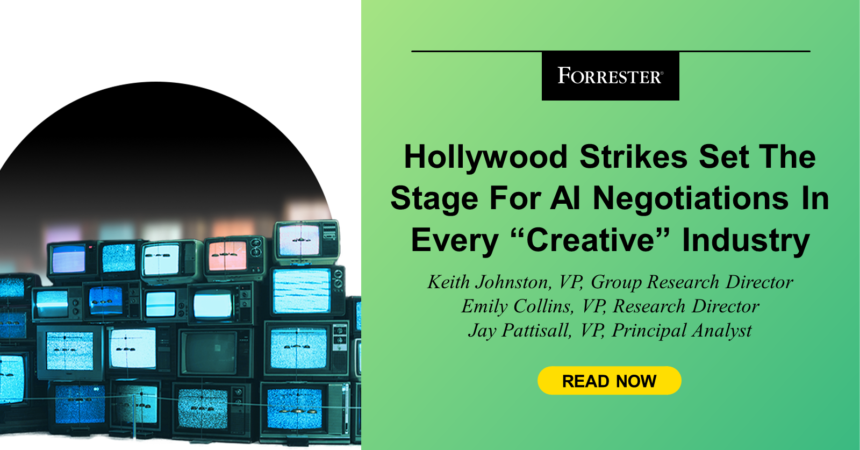Advertising, design, fashion, journalism, publishing. These are just a few of the industries that will be completely changed by the inclusion of artificial intelligence.
On September 27, after 148 days, Writers Guild of America (WGA) leadership voted to end the writers’ strike. Union members will vote on the tentative deal — which covers a minimum pay increase, streaming residuals, and guardrails for the use of AI in writers’ rooms — between October 2 and October 9. SAG-AFTRA leaders also head into talks with the big Hollywood studios this week.
These strikes thrust technology — historically a nonstarter in labor disputes — into the spotlight. The outcome sets a new precedent in the tension between workforce automation and workforce augmentation. A tentative WGA deal outlines several provisions to keep its members at the writers’ table if and when AI is used. For example, studios must hire at least three writer-producers for a guaranteed 10 consecutive weeks of work during the development of a series, and once projects are greenlighted, the minimum of writers increases. Writers are allowed to use AI to help with their work if the studio allows it, but the studios cannot require a writer to use AI software. This agreement also benefits the studios in that it conforms to the “human authorship” standard recently reaffirmed by the US Copyright Office.
Though the agreement marks the end of the 2023 writers’ strike, it’s only the beginning of workplace negotiations aimed to establish controls on the use of technology. Forrester has written extensively about the ways in which AI is revolutionizing work across functions and industries. In all of them, human governance is required to harness AI success. But like any technical revolution, fear is the first response.
Forrester’s 2023 Generative AI Jobs Impact Forecast, US, indicates that generative AI will reshape 4.5 times more jobs than it replaces, with significant impacts to white-collar jobs. Our Agency AI-Powered Workforce Forecast, 2030 (US), predicts that from 2022 to 2030, agencies will replace 7.5% of jobs with automation — but that’s mostly limited to process-oriented roles that are easier to automate, not necessarily conceptual-oriented roles that leverage originality and human ingenuity.
Like advertising, Hollywood has a business model challenge that’s manifesting in labor disruption. The question of whether the WGA should limit the use of generative AI isn’t the real question; it’s whether it is done in the name of cost efficiency or creative effectiveness. Forrester believes in the latter. There is magic in combining AI and creativity.
Creative industries should consider these points:
- Protection of human creativity. You can argue that limiting the use of generative AI is necessary to protect the integrity of human creativity and that AI-generated content lacks the originality and emotional resonance that comes from human experiences and perspectives. AI does not replace or devalue human creativity; it’s a tool to augment and unlock more potential for human creativity, even for more humans who may not have the innate talent to create but do have the mind to ideate.
- Preservation of creative jobs. The concern that the widespread use of generative AI in content creation could lead to job losses is real but not absolute. The problem of strictly limiting its use may protect some jobs in the short term, but it won’t ensure that skills, expertise, or craft are forever preserved. Hollywood has been one of the strongest drivers of computational innovation for decades — AI is the next chapter, not the last.
- Exploration of new creative possibilities. Generative AI has the potential to enhance creative processes rather than replace them. It can be used as a tool to assist writers, generate ideas, or remove repetitive tasks, freeing up more time for writers and artists to focus on the aspects that require an intense human touch, such as storytelling, character development, and emotional depth. More creative opportunities, not fewer, are being produced.
- Governance of ethical risks. There are plenty of ethical concerns around the use of AI-generated content, including issues of consent, ownership, and attribution. Limiting its use could be seen as an answer to these concerns and ensure that AI-generated content is used responsibly and ethically, but as any moviegoer knows, evil strikes first. Creative industries need to band together so that good governance and better business models prevail.
This labor battle waged over technological threats to the integrity of human creativity is the first of many. Generative AI will impact people’s livelihoods, and we must embrace the disruption to own it. Rather than imposing strict limitations, we should advocate for regulations and guidelines that promote responsible and ethical use of AI in every creative industry.
For more insight on generative AI’s influence on the creative industry, Forrester clients can schedule a guidance session.








